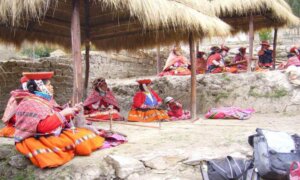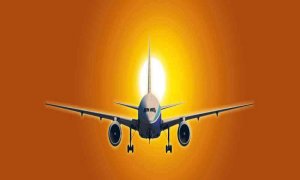Transport as a Component of Tourism: Transportation refers to the process of moving people from one point to another. In the context of tourism transportation refers to carrying tourists from their residences or the places where they live to the tourist destination they want to go to. That is, transportation makes tourist destinations more accessible to the tourist. Transportation however does not just fulfill the functional role of moving people from one place to another. It plays an important role in enriching the overall travel experience for the tourist.
Transportation can become a separate tourism attraction in itself. Part of the joy of the travel experience is the journey to the tourist destination itself with transportation playing an important role in contributing to the pleasure of the journey. Because of these core roles played by the transportation sector, it can be said that tourism starts and ends with tourism. In other words, transportation is one of the most important components of tourism.
The inference may be made here that the tourism department of a country that wishes to promote itself as a tourist destination must pay special attention to its transportation infrastructure that must support various modes of transport.
| Core Factors in Choosing Mode of Transport Time Available for Travel Distance to be Covered Status of the Tourist Comfort Security Price |

Modes of Transport.
Transportation consists of various modes including air, ship, rail and car.
1. Air Transport.
refers to travel that is conducted through aeroplanes which form the transportation mode. The following points may be noted with respect to air transport.
- Air transport is the fastest and safest mode of transport from one point to another.
- Air transport is the preferred mode of travel when very long distances are to be covered.
- Air transport is also preferred when the time for travel is very limited.
- As against these advantages, air transport can also be the most expensive means of travel from one point to another.
- Most aircraft are either from Boeing or from Airbus
- In India, the most popular domestic airlines are Jet Airways, Indigo Airlines, Spice Jet, Go Airlines and Air India.
- Popular International Airlines include British Airways, Lufthansa, Singapore Air, Malaysian Airlines, Emirates, Cathay Pacific, United Airlines and Qatar Airways.
It can therefore be said that air transport has altered perceptions of distance and time where travel is concerned. Because air transport has the effect of reducing time and distance, much of the stimulus to world tourism may be attributed to the growth of the airline sector.
Statistics indicate that despite comparatively higher costs and recent fears and threat of terrorist attacks, air transport is still a very popular means of travelling.
- According to IATA or the International Air Transport Association, airlines carry 3.3 billion people, through almost 50,000 routes across the world.
- There are about 1630 airlines, 27270 aircraft, 3730 airports and 30 million departures annually.
- Air transport alone generates 60 million jobs and almost $2.5 trillion in business activity across the world.
- Thus, air transport is of great economic importance not just to the tourism sector but to the economy of the world as well.
There are various concepts related to airline transport modes. These include
- Regulations. The airline travel sector is a highly regulated industry with airlines expected to comply with several government jurisdictions. The regulations are to ensure safety and security of passengers
- Safety &Security. There are various programs instituted by IATA to ensure safety of passengers and to reduce operational risks. These include programs on what must be done in the event of plane crashes, safety audit procedures, advocacy for upgraded runways and for updated training programs for pilots and cabin crew.
- Open Skies. is a term that refers to the rules and policies that permit national carrier airlines to pass through the airspace of foreign countries and to travel transnationally to foreign countries as well. This policy, especially between countries which have good relationships, frees up air spaces for the travel of passengers and goods.
- Passenger Load Factor. It is a key metric that enables airlines to determine how much of their seating capacity is being used. Load factor for a particular flight is obtained by dividing the total number of passengers by the number of seats. A load factor of ‘1’ means that the aircraft is ‘full’ for a particular sector.
- Low Cost Carriers. Another concept that has become very popular in stimulating tourism is that of low cost carriers or LCC’s. LCC’s have revolutionized tourism because they counter the one disadvantage that airlines have vis-à-vis other modes of transport which is high costs. LCC’s work by charging only for the seat and offering less leg room. All other services including seat reservations, baggage, on board food & drink etc. are charged. This high volume / low service concept has put air travel within the reach of tourists with less disposable incomes.
The following points indicate the latest trends associated with the air transport sector today:
- In order to meet demand, airlines are constantly investing in technological innovations so that more numbers of passengers are carried at less time and with greater comfort.
- Tourism packages generally include air travel components.
- Airlines have the capacity to create positive travel experiences for tourists and hence air travel can become one of the most important tourist attraction factors.
- Airlines contribute to the pleasure of travelling. In this connection, comfort, security and quality of in-flight service are very important components.
- Countries that wish to market themselves as tourism destinations must build new airports, invest in new aircraft and train airline staff.
- Airports are very important part of the air transport experience. This is because tourists get introduced to the destination country first through the airports.
- Hence countries are competing to build modern airports incorporating latest design and state of the art technology and infrastructure which minimizes any discomfort associated with air travel such as long queues, peak time crowd and security checks.
- Increasingly technology is being used to increase the efficiency, convenience, comfort and safety of measures associated with airline transport. This includes booking tickets, registering online, automated check in, baggage control etc.
- There are some disadvantages associated with travelling by air. Some people suffer from chronic fear of flying. Not all areas of the world are accessible by air. Another factor is the amount of time it takes getting to and from airports. Despite these disadvantages however, airline transport is the number one choice for those tourists who travel long distances.
2. Rail Transport.
It refers to any form of transport undertaken by train, trams or metro. Some of the key concepts related to rail transport and tourism are given below:
- Railways are nowadays used by people who wish to travel long distances, at minimal cost. The distance covered by railways is generally less than that covered by aeroplanes and cheaper than airlines.
- Rail transport was originally used to transport freight and goods. It subsequently became the preferred mode of travel for people to travel long distances during the period 1850 – 1950.
- Railways laid the foundation of the modern tourism industry. This was mainly because, starting from the 19th century onwards, railways facilitated the quick transport of large numbers of people across vast expanses of territory for the first time in human history.
- Currently, rail transport is itself a tourist attraction with railway lines – such as the Orient Express – having special features only for tourists.
- Railways today have incorporated technological innovations that enable them to compete with airline and automobile modes of transport. These include faster engines, smooth riding over rails, in-house cafeterias and customized services as well.
- The most recent innovation in train travel is that of speed / fast trains which has necessitated many countries such as France, China, Japan, Singapore and Turkey to completely rebuild their railroad systems.
- Railways today incorporated automated and virtual services that enable tourists to book tickets, choose meals and make seat reservations all from the comfort of their homes or smartphones.
- Metros and trams also have the potential to transport large numbers of people over short distances in very less time. Recognizing the potential of trains and metro trains to reduce discomfort associated with domestic travel, countries are refurbishing existing stations and investing in metro lines.
- The architecture, design and ambience of the metro stations and those of the railway stations contributes to the architectural look and feel of the tourist destinations.
- In India, some of the most train lines that are dedicated to tourists include the following o Maharaja Express – often considered to be the most expensive luxury train in the world, the Maharaja Express covers various tourist destinations of Northern and Western India including Delhi, Ajanta, Udaipur, Jodhpur, Bikaner, Jaipur, Agra, Ranthambore, Varanasi, Gwalior and Khajuraho.
- Palace on Wheels –run by the Rajasthan Tourism Board, follows an 8 day itinerary tour covering the cities of Delhi, Jaipur, Udaipur, Jaisalmer, Jodhpur, Agra, Bharatpur and Chittaurgarh.
- Golden Chariot – covers most of the tourist locations in South India including Bangalore, Mysore, Hampi, Belur, Habebid, Tanjore, Pondicherry, Chennai and Kochi.
- Deccan Odyssey – covers many tourist destinations in Maharashtra including Mumbai, Nasik, Ajanta, Ellora, Kolapur, Sindhugarg, Jaipur, Udaipur and Vadodara. o Royal Rajasthan on Wheels, Fairy Queen & Royal Orient –ferry tourists to various locations in Rajasthan and Gujrat.
3. Water Transport.
It refers to travelling by boat or ship. Some of the key concepts associated with water transport are as follows:
- Travelling by water to cover long distances through ship or boat is the oldest form of transport.
- Modern water based transport started with the invention of the steam engine in the 18th century which eventually lead to the creation of the ocean liners which formed the main mode of transport over long distances before the advent of the airlines in the 1950’s.
- Because of the competition to the long route transport offered by airlines, shipping firms changed their business model from a purely function one to providing travelers with memorable travel experiences and the modern cruise travel industry was created.
- Most water based tourism transport in the world today is associated with cruise liners, yachts and ferries.
- Cruise lines may be considered to be sailing hotels that provide tourists with many luxurious amenities, fine dining and entertainment options.
- Cruises provide tourists with the opportunity of seeing many countries at the same time.
- Cruise lines compete with each other not just on the basis of price but on amenities and facilities provided. They are huge ships employing many employees with the guest / crew ratio invariably being maintained at ‘1’ to ensure tourists are well taken care off.
- Because of the many amenities, facilities and unique features, the cruise liner becomes a tourism destination in itself.
- Cruise travel is the most expensive of all modes of tourist based transport.
- Some of the most popular international cruise lines include the Allure of the Seas. Norwegian Getaway. Anthem of the Seas. Carnival Breeze. Oasis of the Seas.
- The cruise sector in India is not well developed. However, India has some unique means of water based transport that is not found elsewhere in the world. These include the boat houses in the Dal Lake in Srinagar, the boat houses in the lake district of Kerala, the circular coracles that are routinely used to navigate most Indian rivers.
4. Road Transport.
It refers to transport undertaken by car, bus or van. Some of the key concepts associated with road transport are as follows:
- For short distances, much time will be expended if tourists were to travel to airports, check in and wait for departure. For this reason, where distances are short, road transport is the most popular means of transportation.
- It is the quickest and cheapest mode of travel from one point to another when distances are short.
- It provides the tourist with great flexibility to see as many places as possible in the tourist destination. Whereas, such flexibility is not possible with other means of transport including rail, ship and airplane.
- Road transport is dependent on providing proper infrastructure. This includes roads, highways, and tunnels, bridges to ensure tourists have a smooth, secure and comfortable ride from one point to another.
- Road transport is also dependent on providing hotels, motels and restaurants at regular intervals to ensure tourists rest, refresh themselves adequately whilst on tour.
- Currently, technology is being leveraged even in the road sector to improve quality of transport experiences provided to tourists. These innovations include leveraging Global Positioning Systems to navigate and find out routes and technically controlled buses and coaches. It is possible to buy bus tickets online. Coaches have personalized services. It is possible to rent cars for short tours within tourist destinations.
- ‘Smart’ cars, buses and coaches leverage modern technology to provide tourists with data such as estimated time for bus arrivals, weather and temperature, time, route maps, information on must see in the cities / tourist destinations etc.
In Western countries, the road transport infrastructure is very highly advanced and developed. Whereas in India, much needs to be done to improve quality of roads and of other road transport associated infrastructure that ensure tourists travel safely and securely.
Trends and Issues in Transport Sector.
There are several trends and issues associated with the various modes of transport discussed above. These include the following:
Cost of Fuel–The higher the cost of fuel the more expensive do long distance modes of transport such as airlines and cruises become. High cost of transport can become a disincentive for potential tourists to travel.
Labor–The ability to provide very good service that results in customer delight is one of the key challenges in the tourist transportation sector. This is especially true of cabin crew on planes and ships. This is because of the manpower shortages on the one hand and the lack of training / skilling in customer service on the other.
Environmental Impact of Air Transport–The aviation industry is a significant contributor to air pollution and hence of environmental degradation. Air travel has a bigger impact on the environment per kilometer than road or rail modes of transport.
Environmental Impact of Rail Transport–While rail transport is one of the most environmentally friendly modes of transport because of low emissions of carbon dioxide, it does contribute to noise pollution.
Environmental Impact of Water Transport–Cruise liners generated enormous amounts of waste including human waste, run off from showers, dishwaters, bilge water, solid trash waste and chemical waste from oils and solvents. If this waste is dumped into the oceans, it can contribute heavily to environmental pollution.
Environmental Impact of Land Transport–Cars and buses can result in significant amount of air / noise pollution. However, the environmental impact of road transport can be reduced by increasing the number of passengers carried per vehicle and / or using smaller vehicles.
The implication of the above trends and issues is that while transport plays a very important role in the tourism sector, there are potential disadvantages and threats – especially pertaining to preservation of the environment. Transportation thus becomes that component of tourism that also contributes to the degradation of tourist destination. The import here is that transportation must become more sustainable incorporating technological innovations that promote green transportation methods.





